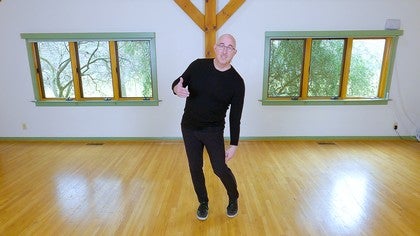Description
About This Video
Transcript
Read Full Transcript
This last section of this online course is about surgery, and I get asked this question all the time from people who suffer from knee pain. Do I really need surgery? And I think a lot of times in our healthcare systems, we go to the doctor when we have knee pain and the doctor sends us to an orthopedic surgeon, who would be a typical line or progression if the knee pain doesn't get better with some pharmaceutical, and we're considered for surgery. We get MRIs, x-rays, and I often get asked this as a physical therapist, because people don't want to have surgery, and they're asking me, do I really need it? So I thought I would take a few moments to explain to you some things to know before surgery, and also some surgery alternatives for a lot of the knee pathologies that we've talked about today, above and beyond exercise and therapeutics.
So let's get started. So we're gonna cover a number of things to know before surgery. I want to talk to you a little bit about this idea of false positives, and I'll explain that. I want to weigh out the risk of surgery and long term degeneration, so a lot of times, people have surgery maybe prematurely and didn't really need that surgery. They could have gotten better without it, with other interventions, but the surgery itself predisposed them for long term injury, so I want to talk a little bit about that.
I also want to discuss some of the non-surgical interventions that are existing today, that, some of them are very successful, and ways to move around that. And then, I do want to discuss surgeries and different types of surgeries, from arthroscopic, open knee surgery, and, of course, total joint replacement. So let's get started with false positives. So a false positive is when we have a diagnosis that is not really the cause of our knee pain, and some of the ways we know that is because, of late, some of our primary diagnostic tools like MRIs, imaging, ultrasound, electrical scans, a lot of the blood tests, those kind of things are used medically to be able to verify if there really is a pathology. And what we have come to learn is that there are a lot of people who don't have any symptoms, but they do have a positive test.
And so, the question always comes back, is your pain related truly to the pathology, or possibly something else? For example, on this slide was a great study that was done looking at what we call a match of people who had knee pain, who had knee pathology. So I'm a 58-year-old male and I have knee pain, and they found another 58-year-old male match me that didn't have knee pain, and we both had MRIs of our knees and we compared the results. So in this study that you're looking at on the slide right now, it is very interesting that, out of hundreds and hundreds of subjects and matches, those that did not have pain are in green and those that had pain are in blue. And you'll notice that they almost go head to head on every single one of the pathologies.
Degeneration was almost 95% of people who didn't have pain had some kind of degeneration. The same thing with cartilage derangements and bone marrow problems, and even with the meniscus, we get down there, we look and find out that those who didn't have pain had a higher incidence of meniscal pathology without pain. So I wanted to make that clear, that just because we go and we get MRI and the doctor says, oh, you have a meniscal tear does not necessarily mean that it is the meniscal tear that is causing our problem. Many people live with meniscal tears and degeneration and arthritis that have never, ever had knee pain. So the question always comes back, is let's assess this a little bit further.
Let's treat a little bit more before we go into surgery. Sometimes surgery is absolutely necessary, but not always. So when we've been approached and one of the options for us is to have a surgery, outside of the false positive and really looking for a secondary assessment, looking for a non-surgical assessment to be able to see if there's any way to avoid surgery, we then have to make the decision, and that decision often is based on a longitudinal decision-making scale. What I mean by that is I might be able to solve the problem today, and I'll give you my own personal example. A number of years ago, I had a very serious tear of a meniscus, a bucket handle tear that came loose.
And what it did is it literally blocked my knee from being able to extend. So I couldn't straight my leg, I couldn't weight-bear on my leg. The torn part of the cartilage got in between the condyle and the tibia. And so, I needed to have pretty much an emergency surgery, not emergency, but an urgent surgery if I wanted to walk and do things, to remove the torn meniscus. Well, prior to that tear of that meniscus, I had never had knee pain.
This is up until the age of 52, 53 years old. I had never had knee pain. I always had hip problems from my sports and my activities, but never knee. So it was interesting that, somehow, I tore this meniscus, had the meniscal tear that I couldn't straighten my knee, I went and got the knee surgery, the arthroscopic surgery, I felt better immediately. The problem, however, was with the shape of my knee and my leg, if you haven't noticed already in the film on the left side, is that I lost stability inside the medial part of the knee, and it started to collapse.
So my varus on the left side really increased and has continued now very rapidly over a period of five years to become highly degenerated and unstable and painful. And so, the question always goes back, I didn't really feel like I had a choice, but I always look at, I mean, we do have a choice of weighing things out, understanding the risk. If I have a piece of the knee removed, a meniscus removed, I will lose some of the stability. There will be more joint play. If I have other joints that have restrictions, it might lead to more degeneration or quicker degeneration of the knee joint.
And that was my case, I had lost some ankle dorsiflexion and I had some old degenerative changes in the hip. So when I lost some stability in the knee from that surgery, the amount of movement now taking place in that knee as the place of least resistance accelerated very quickly and has degenerated the point that I, myself, now am considering a total knee replacement. And hence this course, why we're thinking about surgery. So take into consideration, I think of young athletes that might have a knee injury, and the question is do they have an instability because of that injury? Do they have a loss of mobility because of it?
If they can't function or they have a high loss, like an ACL tear, the knee moves around too much, if you're 14, 15 years old with an ACL tear from playing basketball and we don't repair it, it could lead to a lot more degeneration over time, because of how much joint play. Joint play typically leads to an accelerated degeneration. Any surgery will lead to an accelerated degeneration, just not as fast as an unstable joint. And so, we have to weigh these things out, so getting consultations, meeting with good doctors, good physical therapists. I also am a big fan of second and third opinions of things and looking at it, to be able to weigh out the benefits and the odds of surgery at this time, and how that's gonna play out in the long term.
So before we jump into surgery, there are some non-surgical interventions above and beyond the rehabilitation, neuromuscular reeducation, and therapy that I do that includes a number of things, from stem cell implants and injections, PRP or plasma-rich protein injections, hyaluronic acid injections, and steroids. So I want to go through each of those a little bit and give you an idea, if you're thinking about those, and these tend to be more for degenerative changes, when the joint becomes a little bit more like bone on bone or the cartilage has been degenerated from a long history of injury and surgery. Right now, stem cell, we hear a lot about stem cell, and depending where they get the stem cells, there is mixed feedback in the literature that shows that some stem cells have proven to be very beneficial, especially in animal studies, and we're trying to see now if it's as beneficial in human studies. We don't quite know if it is as much of the stem cell itself or if it is placebo effect, but we are seeing positive effects with it, and it does make sense that we'd be able to take a stem cell that will convert into a true cartilage cell and restore some of the cartilage surface that's been lost from the degeneration. What I think is one of the big variables is, if we don't reeducate the arthrokinematics of the knee after it's received stem cell, or given enough time to be able to form new cartilage cells, that we just continue to promote the same bad behavior inside that knee that caused the degeneration in the first place.
I have an asterisk next to the PRP injections. There's a lot of question on that in, we call them systematic reviews of it. A couple that I've looked at have shown that there is not necessarily any greater effect or not than the placebo effect, so, again, talk to your surgeon and do a little bit of research and see if it really makes a difference. Most of the time, you're paying cash for it, so you pay $1000 for a PRP injection to avoid surgery. Theoretically, what it is is plasma-rich protein from your own blood that would cause scarring, and the thought is that the scarring will create another layer inside the knee joint that can prevent you from being bone on bone.
So there are a lot of people that swear by PRP. The literature right now is sort of mixed 50/50 in it as to whether it is better or not than the placebo effect. Another injection that's used quite a bit now are different types of lubricants that are put into the knee, and they have a temporary purpose. Hyaluronic acid injections are very common and very effective to buy a little more time. I have a patient who is scared to death of total knee replacement.
She's in her seventies, and she has chosen to go the route of physical therapy, Pilates, and injections to be able to maintain the lubricant necessary in her knee. And she walks two, three miles a day and is able to travel with her husband and has a pretty high quality life, and so this could be something that, for somebody who really doesn't want to go down the route of the total knee and doesn't want to take that risk, that there are some other decisions they can make. The last one I have on here is steroids, and steroids have been used for years, especially for systemic diseases like rheumatoid arthritis, and also with lupus and some of the other psoriatic arthritis. And the steroids have a contradiction to them as well. So they feel really good.
I've had a number of steroid injections, and it really does reduce the inflammation, the corticosteroid. It feels great for a while, and then we want another injection and we want another injection. And the more injections we have of a corticosteroid or the more oral or systemic corticosteroids that we take actually has a negative effect on our body. And so, because our body uses and produces cortisol and produces these steroids, it's important that we understand how excessive use of the steroids can have a detrimental effect to our tissues. I remember early in my profession, working with a lot of dancers, and back in those days, it was not uncommon, especially dancers from some of the other countries, that they would get injections with steroid into their tendons, particularly Achilles tendon or patella tendon if they were having pain with jumping, and then we would see, we started seeing a high incidence of things like ruptured Achilles tendons and ruptured patella tendons.
And that's a big no-no now in the orthopedic literatures, that you might do a steroid injection, but you would wait at least six months before you would do another steroid injection because of the risk of too many steroids at once into a tissue can weaken the connective tissue and can lead to other traumas, especially for elite athletes, and especially for lower extremity tendons, like the ones we talked about in the knee, the quadricep tendon and the patella tendon. So, again, for temporary use it could be very helpful for an acute inflammation, a steroid with a hyaluronic acid. Plasma rich protein is debatable right now, and stem cell is up and coming research that we're really hopeful for that could lead to some regeneration. I think all of them would be more effective if they had good Pilates teachers that were teaching them proper arthrokinematics and osteokinematics with graded load while the knee is healing, rather than them just going back to normal lifestyle, moving in their old behaviors and their old habits. So this is just a nice bit of information, hopefully, that can give you enough to talk about or understand when your clients come in, and they say, hey, I just had a hyaluronic acid injection or I just had a PRP injection, that you understand what's going on with them.
And you would think that, if I can help them with graded load and maintaining proper dynamic alignment, the likelihood of it being successful is much, much higher. So I want to talk a little bit about different types of surgeries that are being done on the knees, and ones that are the most common that we hear about on a daily basis, or that maybe many of you have already had, like myself with an arthroscopic meniscectomy. Arthroscopy and laparoscopy are the advances of medicine in surgery that are part of the world of minimally invasive surgeries, and thank goodness. And there are some additional risks to minimally invasive surgeries, because you can't always see the way you could see with an open surgery. On the other hand, with the way that they put fluid in and air into those surfaces, it makes it a lot easier to do the surgery, and less bleeding, less trauma to the soft tissues around it.
So I have here just a simple picture of an arthroscopic procedure with a camera in the knee, looking at a meniscus that's been torn, and also looking at the cartilage of the condyle up above. So the top part of it is the condyle of the femur, and the bottom part is the tibia with the meniscus on it, and the flappy piece is a piece of meniscal tear. And surgeons have the ability to decide whether or not they're going to do a repair or they're going to do a meniscectomy or they're just gonna clean out the debris. And I had shown you some slides of some typical meniscal injuries, and when we make decisions on the meniscal injuries, a lot of it has to do with where the tear is. So the closer the tear is to the outside or the periphery of the meniscus, the more likely it is to heal, because it has blood supply.
The more central it is, the less likely it is to heal, and the more common, if it's interfering or causing blockage or internal derangement, the surgeon will go in and clean that out and make it so that the knee can move without the irritation. So repairs typically need to have blood supply. Surgeons are also using fibrin blood clots that will help that speed up that process, using the same technology for labral tears in the hips and in the shoulders, so you hear about this a lot in the literature. When arthroscopic surgery is not enough and there needs to be more visibility, some surgeries require arthroscopic and open, or it's arthroscopic aided. Some are completely open.
It just depends on how much visibility, how much work needs to be done inside of the knee, so a lot of times, the ligament repairs will have an element of open surgery. There are some who are doing ligament repairs almost completely arthroscopically now, with minimal opening, minimal open surgery. Things like bone and cartilage grafts that have also become quite popular over the last 20 years with degeneration, trying to minimize the need for a total knee. And then, also tibial osteotomy, where they actually remove a piece of the tibia to line up the leg a little bit better and prevent the torque that's going through the knee that might have varus or valgus forces going on. So these are some more aggressive surgeries.
The one that is probably the most common up here is ligament reconstruction. There are surgeons who use allographs, so tissue that comes from something else, whether it's coming from a cadaver, or it could even be a fabric kind of replacement, or it could be your own tissue. So sometimes they'll take tendons from the hamstring or other tendons in the body and construct a ligament and do a reconstruction with that, or sometimes it can just be a repair, where it's not a complete tear and they just fortify and strengthen up those ligaments so that they do their job in preventing accessory motions that are unwanted. So those are some of the surgeries, open surgery. As we finish up with some of the most common knee surgeries, of course, total knee replacements sort of take the, I guess they're the icing on the cake, because there are so many, I think I saw a statistic of 700,000 total knee replacements, I believe, in a year in the world.
And so, these are outstanding numbers of people who are getting total knee replacements. I also have read that a total knee replacement has, within three months, 80% are completely satisfied, within six months, over 90, and that there's only one to 2% that have complications after a year with a total knee replacement, so those numbers have greatly improved. They're still not as good as total hip numbers, but they certainly have improved, and they've improved because of a couple things of automation, robotics, and some of the hardware that they're using. And they're also, the surgeons are really trying to preserve the integrity of soft tissue, so they are trying more and more to be less invasive and less tissue damage and less tissue adaptation. So these are some things to think about, and again, I'm gonna go into great depth in the total knee replacement in the next module, looking at, if you're that person that is considering a total knee replacement, what we need to take into consideration.
So, in this section, again, just to recap, we talked about the idea of false positives, where maybe what you found in the MRI or the x-ray isn't really causing your knee pain, and we need to do a little more investigation and find out and see if there's something else causing it. Number two is looking at alternatives of different types of non-surgical interventions. And then we talked about weighing out the risk factors that are associated with surgery early and how that affects you long term with degeneration and arthritic changes. We talked about different types of surgeries, from arthroscopy to open surgery, and finishing up with total knee replacement. And as it stands right now, the procedures for most of these surgeries have become just mastered, and they're continuing to improve the success rate.
I think back when I was in high school and people who had an ACL rupture and what the likelihood of them getting better was was nothing compared to what we see today. The success rate is so much higher today with these surgeries. The thing that I'd like you to take home from this section is that ounce of prevention's worth a pound of cure. And if we go back and we think of what are the things we need to do to maintain our health in our lower extremities of ankle dorsiflexion, hip mobility, hip strength and control, full knee mobility, avoiding behaviors that create vulnerability and tissue weakness, like sitting too much. And so, if we look at being active and how we work with our children, I believe we can avoid a lot of different degenerative changes and injuries that would come just from behavior.
Again, those who are very active in sports, sort of like I was, are probably gonna end up with their injuries still. There's still a high risk of knee injuries with football and with soccer and with field hockey and lacrosse, and all of those sports, basketball, have a high risk of knee injury from the pivoting and the physical contact. And the key is the more that we can train those knees and those bodies to be spontaneously stable before the injury, then we're less likely to sustain the really severe injuries. So staying mobile, staying in control, all the things we talk about in the Polestar Principles, greatly reduces the risk of injuries, even for high level performers that are in contact sports, et cetera. I hope this information has been beneficial to you.
I do want you to always remember that, just sort of the disclaimer here, is that how important it is for you to make sure that you get professional advice when you're dealing with major knee injuries. These professionals have been trained for years. They do know what they're talking about. Just understand that we all look through things in different lenses, so me as a physical therapist sees it one way, a surgeon, maybe another, a chiropractor, a different manner, an athletic trainer, different, and that the more information we gather the more education we have, as I said in the very beginning, allows us to make better decisions, allows us to prepare better, allows us to anticipate better and to recover faster. I hope this information's been helpful, and we'll see you in another episode or workshop here on Pilates Anytime.
Knee Health - Playlist 1: The Injured Knee and its Recovery
Comments
You need to be a subscriber to post a comment.
Please Log In or Create an Account to start your free trial.











